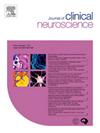偶发性颅内小动脉瘤的自然史:关于随访时间和动脉瘤位置对破裂风险报告影响的系统回顾和汇总分析
IF 1.9
4区 医学
Q3 CLINICAL NEUROLOGY
引用次数: 0
摘要
背景未破裂的颅内小动脉瘤(sUIAs)的检出率不断上升,这给临床带来了挑战,需要仔细考虑破裂的低但真实的风险和介入治疗的潜在发病率。受设计、患者选择、动脉瘤位置和随访时间异质性的影响,不同研究报告的破裂率差异很大。本研究评估了动脉瘤位置和随访时间对未经治疗的sUIAs破裂率的影响。方法按照PRISMA指南进行了系统综述和荟萃分析,并在PROSPERO(CRD42024601692)上进行了注册。在四个数据库(EMBASE、Ovid MEDLINE、EMCARE、Scopus)中检索了 2000 年 1 月以后报告纵向结果的研究,研究对象为≥20 个未经治疗的≤5 mm 的 sUIA。主要结果是按部位和随访时间分类的总破裂率。次要分析考察了动脉瘤的生长情况。采用随机效应模型进行荟萃分析,使用I2统计量评估异质性。敏感性分析评估了研究结果的稳健性。结果从10694份筛选记录中,有28项研究符合纳入标准,包括10495个未经治疗的≤5 mm的sUIA。在平均 38 个月的随访中,97 个动脉瘤破裂,总破裂率为 0.8%(95% CI,0.6-1.2)。不同部位的动脉瘤破裂风险差异不大(P = 0.31):大脑中动脉破裂率为 1.1%,大脑前动脉破裂率为 3.9%,眼旁动脉瘤破裂率为 0.3%。不同随访时间段的破裂率保持一致(p = 0.53):20个月为0.8%,20-40个月为0.8%,40个月为1.2%。结论这项更新的荟萃分析纳入了按部位和随访时间进行的新亚组分析,证实在平均 38 个月的随访期间,≤ 5 mm 的 sUIA 破裂风险仍然很低(1%)。然而,有限的长期数据限制了在此时间范围之外的准确风险评估,动脉瘤位置的漏报也影响了特定部位的风险评估。随着随访时间的延长,动脉瘤的增大趋势突出了持续监测的重要性。本文章由计算机程序翻译,如有差异,请以英文原文为准。
Natural history of small incidental intracranial aneurysms: a systematic review and pooled analysis on the influence of follow-up duration and aneurysm location on rupture risk reporting
Background
The rising detection of small unruptured intracranial aneurysms (sUIAs) poses a clinical challenge, requiring careful consideration between the low but real risk of rupture and the potential morbidity of intervention. Reported rupture rates vary widely across studies, influenced by heterogeneity in design, patient selection, aneurysm location, and follow-up duration. This study assessed how aneurysm location and follow-up length affect rupture rates in untreated sUIAs.
Methods
A systematic review and meta-analysis were conducted in line with PRISMA guidelines and registered with PROSPERO (CRD42024601692). Four databases (EMBASE, Ovid MEDLINE, EMCARE, Scopus) were searched for studies from January 2000 onwards reporting longitudinal outcomes for ≥20 untreated sUIAs ≤ 5 mm. The primary outcome was the pooled rupture rate, stratified by location and follow-up duration. Secondary analysis examined aneurysm growth. A random-effects model was used for meta-analysis, with heterogeneity assessed using the I2 statistic. Sensitivity analyses evaluated the robustness of findings.
Results
From 10,694 screened records, 28 studies met inclusion criteria, encompassing 10,495 untreated sUIAs ≤ 5 mm. Over a mean follow-up of 38 months, 97 aneurysms ruptured, yielding a pooled rupture rate of 0.8 % (95 % CI, 0.6–1.2). Rupture risk did not significantly differ by location (p = 0.31): 1.1 % for middle cerebral artery, 3.9 % for anterior cerebral artery, and 0.3 % for para-ophthalmic artery aneurysms. Rupture rates remained consistent across follow-up durations (p = 0.53): 0.8 % for <20 months, 0.8 % for 20–40 months, and 1.2 % for >40 months. Although aneurysm growth appeared more frequent with longer follow-up, this was not statistically significant (p = 0.64).
Conclusion
This updated meta-analysis, incorporating novel subgroup analyses by location and follow-up duration, confirms that rupture risk for sUIAs ≤ 5 mm remains low (<1%) over an average 38-month period. However, limited long-term data restrict accurate risk estimation beyond this timeframe, and underreporting of aneurysm location impairs site-specific risk assessment. The trend towards greater aneurysm growth with extended follow-up underscores the importance of continued surveillance.
求助全文
通过发布文献求助,成功后即可免费获取论文全文。
去求助
来源期刊

Journal of Clinical Neuroscience
医学-临床神经学
CiteScore
4.50
自引率
0.00%
发文量
402
审稿时长
40 days
期刊介绍:
This International journal, Journal of Clinical Neuroscience, publishes articles on clinical neurosurgery and neurology and the related neurosciences such as neuro-pathology, neuro-radiology, neuro-ophthalmology and neuro-physiology.
The journal has a broad International perspective, and emphasises the advances occurring in Asia, the Pacific Rim region, Europe and North America. The Journal acts as a focus for publication of major clinical and laboratory research, as well as publishing solicited manuscripts on specific subjects from experts, case reports and other information of interest to clinicians working in the clinical neurosciences.
 求助内容:
求助内容: 应助结果提醒方式:
应助结果提醒方式:


